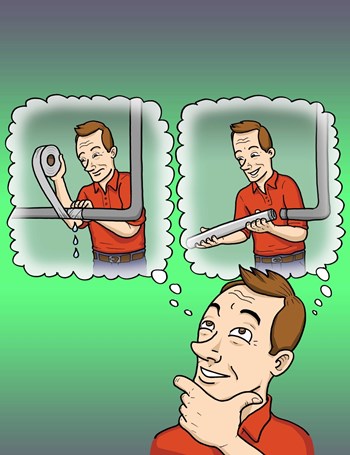
It's a common enough story: the condominium was relatively new, but from the start its board of directors was stingy with maintenance and repair dollars. Then the recession struck, and the percentage of unpaid maintenance fees spiked. After several years of neglected physical facilities, half the condo's elevators weren’t working. Unpainted interior hallways and uncleaned carpeting and tile encouraged mold and mildew growth. Utility bills went unpaid for so long that the electric company threatened to cut off the power, and garbage collection was sporadic. Due to mismanaged collections and finances, the community is now teetering on the verge of bankruptcy.
Luckily, the economy has improved a bit but staying ahead financially has not gotten any easier, and that goes for associations as well. “It's the dollar figure. If associations have the money they're going to say: ‘Okay, let's get it repaired.’ If they don't they're going to say, 'No let's put it off, let's wait another six months, maybe we'll be in a better financial situation' than they are now,” says Dominick Frontera, president of World Wide Construction in Ridgefield Park. “Money is the reason why people don't want their maintenance raised because they say that can't afford it. And you can understand that, but the money has to come from somewhere to make those repairs,” he says. If you don't, the hole can only get deeper.
Absolute Essentials
Industry experts believe that at the top of everyone’s maintenance list should be life-safety items for which code violations could prompt steep fines from a government inspector, or even closure of a building. This includes elevators, fire extinguishers, sprinkler systems, smoke alarms, carbon monoxide detectors, and painting of curb corners to meet fire-marshal requirements. These tend to be less expensive, and they're huge liability issues as well, so getting them taken care of is a matter of necessity.
Safety items rarely pull you down a money pit. When it comes to the physical construction of the building, a bad roof can have the most disastrous consequences if neglected because it can cause a chain reaction. “If that roof is leaking, it's penetrating into the floor below that and maybe even the floors lower than that. It causes damage on the walls, mold, mildew, flooring gets destroyed, and the calking of your windows—it allows heat to escape,” says Frontera.
“And of course, your brick, your facades. During the winter time, if water's behind that brick, it freezes, and it causes those bricks to start popping. If that brick falls and hits someone in the sidewalk—big lawsuit,” he says. Of course, not everyone has a brick facade, but the point remains. A dilapidated roof can turn into a dilapidated building, and quickly.
Where Water Resides
Experts say that water leaks are the leading cause of damage in condominiums and believe that most leaks run between walls, underground, and/or in areas that are not readily visible. Raised sidewalks, water bubbling on the lawn, and spidering around storm drains may disclose underlying problems with storm-water and fresh-water lines needing prompt attention. A big part of keeping the inside of homes dry is often overlooked: sealants.
“Sealants typically have a life span of five to seven years. They need to be inspected regularly and they need to be replaced before the end of their life span,” says Mark Harris Berman, AIA, PP, UD an architect and professional planner principal at Berman & Wright in Somerville. “I've seen numbers of buildings that are maybe 20 years old, and it's the original sealant material.” How the sealants are installed can also make a big difference. “Sometimes they are improperly designed, sometimes they are improperly installed, sometimes they're improperly maintained,” he says.
What Can Be Deferred
It's logical enough that the big projects shouldn't be put off—if it means putting the entire building in jeopardy. “Buildings are intended to act as systems, integrated and if one section of that fails, it's possible to impact another section,” Berman continues. But, associations run into financial pinches all the time. Surely there must be something that can be put off. “Well, there's a certain time when they can put certain things off, but it doesn't get any better. It just gets progressively worse,” says Frontera. “So if you allow that brick to start popping, it doesn't get any better it just gets worse.”
One way to lighten the load, says Berman, is for associations to stagger their maintenance schedules, so the expenses don't hit all at once. “An association can choose to do a maintenance schedule where they're replacing their sealants on different buildings in different years so that they're not bearing the costs of all the work at one time,” he says.
Another option, according to Frontera, is to simply get as much done in one maintenance project. For instance, if one floor needs facade work, take care of everything else while the tools, the labor, and the setup are all in place. “We offer to our clients a payout plan, if need be, where they give us ‘x’ amount of dollars down, and every month they'll pay us so much,” says Frontera. Associations should explore companies that offer such plans.
It mostly goes without saying, but if a building falls down the slippery slope of disrepair, the consequences can be dire. “I know of a building that was finally condemned. The people had to evacuate and find other places to live. And unfortunately the association was forced to come up with some kind of funding to house them until they were able to fix their building,” says Frontera. Associations shouldn't take the maintenance budget lightly, for the simple reason that they are on the hook if things go south, he says.
An association with a reserve study and a reserve budget might set aside money for routine projects such as painting or larger repairs. A reserve study is a good way to lock in money, so when it's needed it's there, and there's no tussling. But, even if reserves are properly funded, they don’t cover certain emergencies, such as a lightning strike that blows up the air-conditioning compressor. Reserve studies can also help associations come up with creative ways to get more out of their infrastructure if they follow diligent repair schedules. The life of domestic water pumps and motors can be prolonged by having multiple units and setting them to run on an alternating basis. Thus, if a pump motor is made to last 20 years, alternating between pumps may yield another five to 10 years from each motor.
For some associations, pinching pennies is a dangerous balancing act, and if they fall by the wayside, the results are observable. “The more you maintain your building, the more it's attractive to a prospective buyer. The more you allow it deteriorate, somebody walks in and they see stains on the ceiling, stains on the wall, paint chipping off the windows and so forth, they're going to think twice about purchasing it. It just increases value by maintaining your building,” says Frontera.
The onus is on the association or board, but a good adviser can be invaluable when it comes to keeping on top of repairs. “Boards can be diligent in having their property managers and property management companies understand what the requirements are for their particular buildings, and if they don't already have some kind of program and schedule implemented they could go ahead and have that work done by a professional, who does understand the requirements,” says Berman. Building leaders also have a plethora of information to self-educate. “There is tons of information out there, and I'm sure associations like the Community Associations Institute (CAI) have programs for property managers to bring them up to speed. A little bit of knowledge goes a long way,” says Berman.
Seeking Professional Guidance
Experts say that another way to educate yourself is also just talking to other associations and boards. “I'm the board president of a building and every six months we send out a flyer: 'Please list any items that you think should be addressed now or in the near future.' Because during six months, you know something could start to leak, and they say 'oh, it's leaking, I have to tell someone,' but they don't. But by them getting this form they fill it out and they return it and those items can be addressed,” says Frontera. Fixing little things is a stop-gap measure but sometimes can avoid headaches if they turn into larger capital projects.
As painful as it is to spend money on repairs, especially if it looks like it can be put off just a little longer, it’s imperative to enlist the help of qualified professionals to formulate a plan, and stick to that plan and just get it done.
George Leposky is a freelance writer and a frequent contributor to The New Jersey Cooperator and other publications. Editorial Assistant Tom Lisi contributed to this article.






Leave a Comment